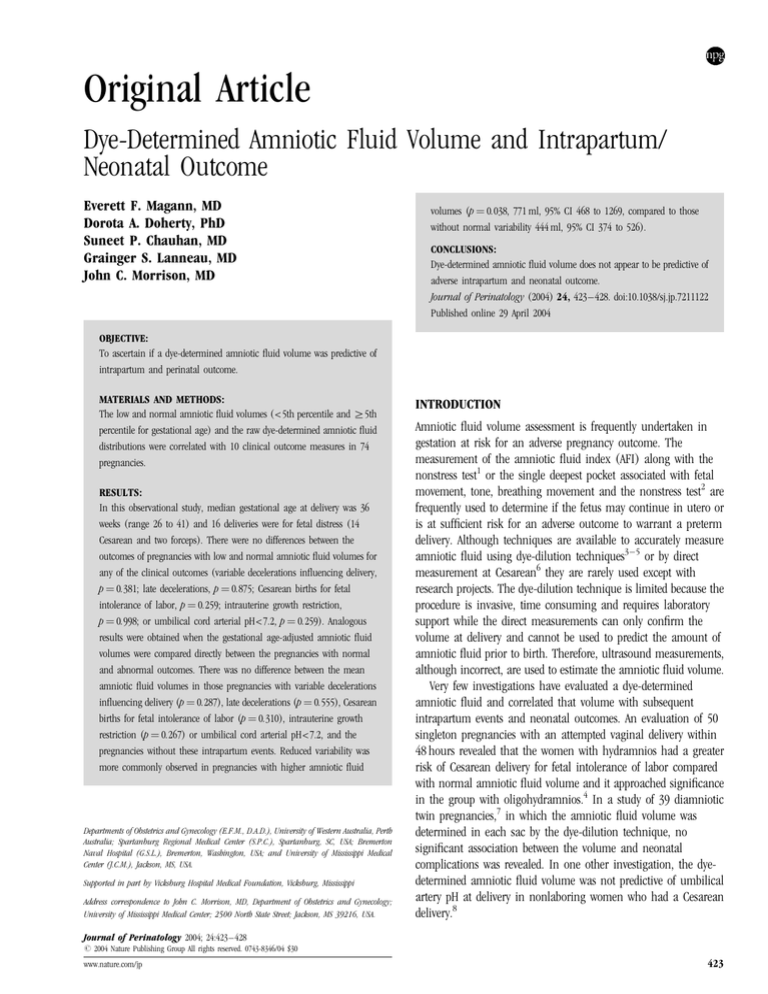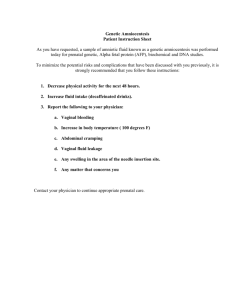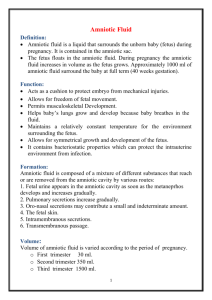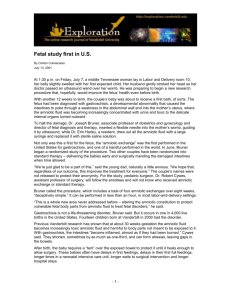
Original Article
Dye-Determined Amniotic Fluid Volume and Intrapartum/
Neonatal Outcome
Everett F. Magann, MD
Dorota A. Doherty, PhD
Suneet P. Chauhan, MD
Grainger S. Lanneau, MD
John C. Morrison, MD
volumes (p ¼ 0.038, 771 ml, 95% CI 468 to 1269, compared to those
without normal variability 444 ml, 95% CI 374 to 526).
CONCLUSIONS:
Dye-determined amniotic fluid volume does not appear to be predictive of
adverse intrapartum and neonatal outcome.
Journal of Perinatology (2004) 24, 423–428. doi:10.1038/sj.jp.7211122
Published online 29 April 2004
OBJECTIVE:
To ascertain if a dye-determined amniotic fluid volume was predictive of
intrapartum and perinatal outcome.
MATERIALS AND METHODS:
The low and normal amniotic fluid volumes (<5th percentile and Z5th
percentile for gestational age) and the raw dye-determined amniotic fluid
distributions were correlated with 10 clinical outcome measures in 74
pregnancies.
RESULTS:
In this observational study, median gestational age at delivery was 36
weeks (range 26 to 41) and 16 deliveries were for fetal distress (14
Cesarean and two forceps). There were no differences between the
outcomes of pregnancies with low and normal amniotic fluid volumes for
any of the clinical outcomes (variable decelerations influencing delivery,
p ¼ 0.381; late decelerations, p ¼ 0.875; Cesarean births for fetal
intolerance of labor, p ¼ 0.259; intrauterine growth restriction,
p ¼ 0.998; or umbilical cord arterial pH<7.2, p ¼ 0.259). Analogous
results were obtained when the gestational age-adjusted amniotic fluid
volumes were compared directly between the pregnancies with normal
and abnormal outcomes. There was no difference between the mean
amniotic fluid volumes in those pregnancies with variable decelerations
influencing delivery (p ¼ 0.287), late decelerations (p ¼ 0.555), Cesarean
births for fetal intolerance of labor (p ¼ 0.310), intrauterine growth
restriction (p ¼ 0.267) or umbilical cord arterial pH<7.2, and the
pregnancies without these intrapartum events. Reduced variability was
more commonly observed in pregnancies with higher amniotic fluid
Departments of Obstetrics and Gynecology (E.F.M., D.A.D.), University of Western Australia, Perth
Australia; Spartanburg Regional Medical Center (S.P.C.), Spartanburg, SC, USA; Bremerton
Naval Hospital (G.S.L.), Bremerton, Washington, USA; and University of Mississippi Medical
Center (J.C.M.), Jackson, MS, USA.
Supported in part by Vicksburg Hospital Medical Foundation, Vicksburg, Mississippi
Address correspondence to John C. Morrison, MD, Department of Obstetrics and Gynecology;
University of Mississippi Medical Center; 2500 North State Street; Jackson, MS 39216, USA.
INTRODUCTION
Amniotic fluid volume assessment is frequently undertaken in
gestation at risk for an adverse pregnancy outcome. The
measurement of the amniotic fluid index (AFI) along with the
nonstress test1 or the single deepest pocket associated with fetal
movement, tone, breathing movement and the nonstress test2 are
frequently used to determine if the fetus may continue in utero or
is at sufficient risk for an adverse outcome to warrant a preterm
delivery. Although techniques are available to accurately measure
amniotic fluid using dye-dilution techniques3–5 or by direct
measurement at Cesarean6 they are rarely used except with
research projects. The dye-dilution technique is limited because the
procedure is invasive, time consuming and requires laboratory
support while the direct measurements can only confirm the
volume at delivery and cannot be used to predict the amount of
amniotic fluid prior to birth. Therefore, ultrasound measurements,
although incorrect, are used to estimate the amniotic fluid volume.
Very few investigations have evaluated a dye-determined
amniotic fluid and correlated that volume with subsequent
intrapartum events and neonatal outcomes. An evaluation of 50
singleton pregnancies with an attempted vaginal delivery within
48 hours revealed that the women with hydramnios had a greater
risk of Cesarean delivery for fetal intolerance of labor compared
with normal amniotic fluid volume and it approached significance
in the group with oligohydramnios.4 In a study of 39 diamniotic
twin pregnancies,7 in which the amniotic fluid volume was
determined in each sac by the dye-dilution technique, no
significant association between the volume and neonatal
complications was revealed. In one other investigation, the dyedetermined amniotic fluid volume was not predictive of umbilical
artery pH at delivery in nonlaboring women who had a Cesarean
delivery.8
Journal of Perinatology 2004; 24:423–428
r 2004 Nature Publishing Group All rights reserved. 0743-8346/04 $30
www.nature.com/jp
423
Magann et al.
The purpose of this investigation was to re-examine the dyedetermined AF volume in a population of women who delivered
within a short period of time from the assessment of the amniotic
fluid volume and ascertain if that volume is predictive of
intrapartum events or a poor perinatal outcome.
MATERIALS AND METHODS
This prospective observational trial took place between July of 1993
and January of 2001. None of the women in this study have been
previously reported and are not the same participants in other
investigations from our group.3,4,7,8 Women undergoing an
amniocentesis for the evaluation of fetal lung maturity because
of a maternal or fetal complication of pregnancy were eligible
for this study. Additionally, if the fetal lungs were mature or if
the lung profile was not mature and the woman went into
spontaneous labor there had to be no contraindication to a vaginal
delivery. All women had to either be induced or enter spontaneous
labor within 72 hours of the amniocentesis. There were no
procedurally related complications such as fetal distress or rupture
of membranes in conjunction with the amniocentesis. In all,
72 hours was selected as a time interval to evaluate the impact of
labor on a known amniotic fluid volume because the two
investigations of amniotic fluid volume across gestation both
confirmed the stability of the amniotic fluid volume in the late
second and early third trimesters of pregnancy.9,10 Consequently,
the dye-determined amniotic fluid volume at dye-determined
amniocentesis should reflect the volume at delivery within
72 hours. All of the women had intact membranes at the time of
the amniocentesis. Patients agreeing to participate in this study
had their amniotic fluid volume determined by the dye-dilution
technique using aminohippurate and a diazo-dye reaction with
subsequent spectrophotometric analysis. The Investigational
Review Board at the University of Mississippi Medical Center
approved this study.
An ultrasound directed amniocentesis was undertaken using
sterile technique. Following removal of 10 ml of amniotic fluid for
the assessment of fetal lung maturity, 2 ml of a 20% aqueous
solution of aminohippurate sodium (Merck and Company Inc,
West Point, PA) was injected into the amniotic cavity. Over the next
20 minutes, the needle was left in place and the fetus was observed
continuously with ultrasound. The plunger of the syringe attached
to the amniocentesis needle was withdrawn and depressed several
times to promote mixing of the amniotic fluid/aminohippurate
mixture. A volume of 3 ml of the amniotic fluid/aminohippurate
mixture was removed at 20 minutes and was then frozen at 201C
until assayed for the aminohippuric acid concentration. The time
necessary for the complete mixing and the proper storage
temperature to maintain stability for accurate test results has been
previously reported.3,4 The amniotic fluid volume by this
424
Amniotic Fluid Volume
dye-dilution technique has been shown to accurately reflect the
actual amniotic fluid volume in vivo.11
Aminohippuric acid concentrations and amniotic fluid volumes
were determined using the diazo-dye reaction spectrophotometric
techniques of Charles and Jacoby.12 The intra-assay and interassay
coefficients of variation were 1.9 and 3.5%, respectively. The dyedetermined amniotic fluid volumes were labelled as low, normal,
and high according to published normal volumes by gestational
age for this specific patient population.
Induced and spontaneous labors were evaluated for the presence
of recurrent variable and late decelerations that influenced delivery,
meconium-stained amniotic fluid, and Cesarean delivery for
nonreassuring fetal assessment. All women received continuous
external fetal monitoring and then internal monitoring after the
cervix was sufficiently dilated to permit rupture of the membranes
and the placement of a scalp electrode and internal pressure
transducer. Fetal heart rate variability was defined as absent,
decreased (<5 beats/minute), average (6 to 25 beats/minute) and
increased (>25 beats/minute). Fetal intolerance of labor was
defined as severe variable decelerations, late decelerations, and/or
fetal bradycardia with minimal or absent variability which did not
respond to maternal position change, fluid bolus, oxygen therapy,
discontinuation of oxytocin if it was being infused, and tocolytic
therapy. One investigator who was unaware of the amniotic fluid
volume and the peripartum outcome performed the interpretation
of the tracing. Continuous amnioinfusions were undertaken in
pregnancies with thick meconium-stained amniotic fluid and in
pregnancies with recurrent severe variable fetal heart rate
decelerations. All pregnancies were assessed for birth weight and
umbilical cord arterial pH at delivery. Intrauterine growth
restriction (IUGR) was defined as a neonatal birth weight that
<10th percentile by weight for gestational age. The dye-determined
values were performed in lots and not calculated until after the
patients had delivered. Accordingly, the clinicians managing the
patients did not know the result of the dye-determined volume.
Descriptive statistics utilized frequency distributions for
categorical data and medians and interquartile ranges for
continuous measurements. Primary statistical analysis involved
comparisons of outcomes between the pregnancies with low
amniotic fluid volume (<5th percentile for gestational age) and
those with amniotic fluid volume above the 5th percentile for
gestational age. Fisher’s exact test was used for the univariate
analysis and logistic regression with exact inference was used to
adjust for gestational age at delivery when appropriate. Secondary
statistical analysis compared the dye-determined amniotic fluid
volumes between the pregnancies with normal and adverse
perinatal outcomes using analysis of covariance adjusting for
gestational age at delivery. Amniotic fluid volume and gestational
age at delivery were transformed to achieve data normality (logtransformation for the amniotic fluid volume and square root
transformation for gestational age at delivery). S-Plus and LogXact
Journal of Perinatology 2004; 24:423–428
Amniotic Fluid Volume
Magann et al.
statistical software was used for the analysis.13,14 p-values <0.05
were considered statistically significant.
RESULTS
The maternal characteristics of age, race, gravidity, parity, and
summary of a significant past medical history or pregnancy
complications of these 74 women are summarized in Table 1. The
dye-determined amniotic fluid volume ranged between 85 and
2526 ml with the median volume of 517 ml (interquartile range
292 to 687 ml). There were 27 cases (37%) in which the dyedetermined amniotic fluid volume was below the 5th percentile for
gestational age, and one case in which the amniotic fluid volume
was above the 95th percentile for gestational age. There were no
differences between the patient characteristics with respect to the
dye-determined amniotic fluid volume <5th percentile and Z5th
percentile for gestational age (Table 1).
Median gestational age at delivery was 36 weeks (range 26 to
41). As noted in Table 2 the median birth weight in this patient
series was 2323 g (range 750 to 4840), and 13 cases (18%) of
IUGR. Fetal distress during labor developed during 16 deliveries
(22%), 14 of these women were delivered by Cesarean section and
two by instrumental vaginal delivery. In total, 30 women presented
with variable decelerations and in nine instances the delivery was
influenced by decelerations. Variability was abnormal in eight
women (seven cases of minimal/absent and one case of increased
variability). Late decelerations influenced delivery in seven out of
10 cases where decelerations were present. No statistically
significant differences in perinatal outcomes between the
pregnancies with amniotic fluid volume < 5th percentile versus
Z5th percentile for gestational age were found (Table 2). The
only exception was admission to special care nursery that was
univariately significant (p ¼ 0.036), however, the amniotic fluid
volume was no longer statistically significant with the adjustment
for gestational age at delivery (p ¼ 0.243); Furthermore, nine out
of 10 special care nursery admissions due to respiratory causes
included the infants delivered between 26 and 33 completed
pregnancy weeks. The remaining two admissions where the
admission reason was recorded include one admission for
respiratory distress at 36 weeks gestational age in pregnancy with
the dye-determined amniotic fluid volume Z5th percentile for
gestational age, and one case of admission for shoulder dystocia. In
this study there were 16 cases where newborn intensive care
admissions were required (10 for respiratory distress, one for
congenital anomaly (unsuspected isolated ventricular septal
defect), one for shoulder dystocia, four reasons not recorded). Only
one case with meconium staining was observed and it was termed
light.
The summary of dye-determined amniotic fluid volumes
comparing those volumes of the pregnancies influenced by
intrapartum and perinatal events with those pregnancies that were
not affected is recorded in Table 3. No statistically significant
differences in amniotic fluid volume were found between those
pregnancies with and those without variable decelerations
(p ¼ 0.287), late decelerations (p ¼ 0.555) or fetal distress
(p ¼ 0.310). Statistically significant differences were found between
the deliveries with normal variability compared with the low or
absent variability (p ¼ 0.038) where normal variability was
associated with lower dye-diluted amniotic fluid volume (estimated
mean 443, 95% CI 374 to 525 ml, versus 770 ml, 95% CI 468 to
1269 ml) in those women with minimal/absent variability.
Table 1 Maternal and Delivery Characteristics
Maternal age*
Gravidity
Primi
Multi
Parous
Race
White
Black
Other
Any medical historyw
Any prenatal complicationsz
All
(N ¼ 74)
AFVr5th %
(N ¼ 27)
AFV>5th %
(N ¼ 47)
p-value
24 (14 to 38)
24 (20 to 28)
24 (20 to 30)
0.963
19 (26%)
55 (74%)
53 (72%)
12 (26%)
35 (74%)
33 (72%)
7 (26%)
20 (74%)
19 (70%)
0.970
0.901
11 (15%)
58 (78%)
4 (5%)
19 (26%)
44 (59%)
5 (11%)
37 (80%)
4 (9%)
13 (26%)
26 (55%)
6 (22%)
21 (78%)
F
6 (22%)
18 (67%)
0.148
0.606
0.339
*Medians and interquartile ranges (1st to 3rd quartile) are shown.
w
Chronic hypertension (n ¼ 7), diabetes (n ¼ 4), drug abuse (n ¼ 4), seizure disorder (n ¼ 2), lupus (n ¼ 1) and sickle cell disease (n ¼ 1).
z
Pregnancy induced hypertension (n ¼ 10), oligohydramnios (n ¼ 16), hydramnios (n ¼ 5), PPROM (n ¼ 7), others (n ¼ 6).
Journal of Perinatology 2004; 24:423–428
425
Magann et al.
Amniotic Fluid Volume
Table 2 Delivery Characteristics
All (N ¼ 74)
(N ¼ 74)
Variable decelerations
Present
Influencing delivery
Variability
Minimal/absent, hyper
Influencing delivery
Late decelerations
Present
Influencing delivery
Fetal distress
Mode of delivery
Vaginal
CS
Gestational age (weeks)*
Preterm delivery
Birth weight (grams)*
IUGR
pH<7.2
NICU admissionsw,z
AFVr5th %
(N ¼ 27)
AFV>5th %
(N ¼ 47)
p-value
30 (41%)
9/30 (30%)
9 (33%)
3 (33%)
21 (45%)
6 (29%)
0.461
0.381
8 (10%)
8/8 (100%)
1 (4%)
1 (100%)
7 (15%)
6 (86%)
0.725
0.875
10 (14%)
7/10 (70%)
16 (22%)
4 (15%)
4 (66%)
4 (15%)
6 (13%)
3 (75%)
12 (26%)
0.999
0.667
0.383
57 (77%)
17 (23%)
36 (34 to 38)
43 (59%)
2323 (1615 to 3315)
13 (18%)
16 (22%)
15 (21%)
23 (85%)
4 (15%)
35 (33 to 38)
17 (65%)
2780 (1810 to 3360)
5 (19%)
3 (11%)
9 (35%)
34 (72%)
13 (28%)
36 (35 to 38)
26 (55%)
2800 (2470 to 3300)
8 (17%)
13 (28%)
6 (13%)
0.259
0.162
0.463
0.241
0.999
0.143
0.036
*Medians and interquartile ranges (1st to 3rd quartile) are shown.
w
Excludes one NICU admission due to congenital abnormality.
z
Significant differences were found with respect to the NICU admissions in a univariate analysis, however, no significant differences were found while controlling for gestational age
at delivery (p ¼ 0.243).
Table 3 Summary Statistics for Dye-diluted AF Volume (ml) Stratified by Factors that Influenced Delivery and Neonatal Outcomes. Medians and
Interquartile Ranges (1st to 3rd quartile) are Shown
Outcomes
Influenced delivery
Delivery
Variable decelerationsw
Variability
Late decelerationsz
Fetal distress
650 (310 to 1041)
670 (557 to 1276)
579 (298 to 1276)
572 (374 to 771)
Neonatal outcomes
IUGR
pH<7.2
NICU admissiony
Adverse outcome
389 (269 to 617)
517 (260 to 681)
338 (254 to 542)
p-value*
Not influenced delivery
526
449
522
421
(299
(263
(280
(253
to
to
to
to
823)
674)
690)
687)
0.287
0.038
0.555
0.310
Normal outcome
525 (288 to 749)
541 (320 to 757)
534 (302 to 723)
0.267
0.144
0.338
*p-values shown were obtained using ANCOVA analysis of log-transformed AF volumes adjusted for gestational age at delivery.
w
Data for cases where variable decelerations were present is shown; median and AF volume in 44 cases without variable decelerations was 443 ml (interquartile range 260 to 662 ml).
z
Data only for cases where late decelerations influenced delivery and no late decelerations present are shown, excluding two cases of late decelerations present and not influencing
delivery.
y
One NICU admission excluded from the analysis due to congenital abnormality.
The amniotic fluid volumes were also similar in the women
undergoing an amnioinfusion for fetal intolerance of labor
(571±293) and the women not undergoing an amnioinfusion
426
(579±443) (p ¼ 0.566). The dye-determined amniotic fluid
volume was lower in pregnancies with the fetal umbilical artery
pH<7.2 and in pregnancies with IUGR, although these differences
Journal of Perinatology 2004; 24:423–428
Amniotic Fluid Volume
in amniotic fluid volume failed to reach statistical significance
(p ¼ 0.144 and 0.267, respectively, Table 3). Lower amniotic fluid
volumes adjusted for gestational age at delivery were observed
among the pregnancies associated with the intensive care
admissions but this factor did not reach statistical significance
(population means at 37 completed pregnancy weeks of 367 ml,
95% CI 234 to 575 ml, versus 484 ml, 95% CI 410 to 577 ml;
p ¼ 0.249).
DISCUSSION
The ultrasound estimate of oligohydramnios has been linked with
adverse intrapartum and perinatal outcomes including an
increased risk of variable decelerations, Cesarean deliveries for fetal
distress and low Apgar scores1,15 However not all investigators agree
on the predictability of an ultrasound estimate of amniotic fluid
volume to foretell an adverse outcome. The reliability of the actual
volume of amniotic fluid to forecast adverse outcomes is even more
problematic. The potential procedural risks and the requirement of
calculations for a dye-determined amniotic fluid volume make the
evaluation impractical except for research purposes. Despite these
drawbacks, an evaluation using measured volumes and pregnancy
outcomes has great potential to further our understanding of the
impact, if any, of amniotic fluid volume and pregnancy outcome.
This prospective observational study evaluated the influence of
dye-determined amniotic fluid volume on both intrapartum and
perinatal outcomes. The mean amniotic fluid volume of those
pregnancies with variable decelerations influencing delivery,
minimal/absent (or increased variability), late decelerations,
Cesarean deliveries for fetal distress, and umbilical artery pH was
<7.2 was not different than the amount of amniotic fluid in those
pregnancies without those intrapartum and neonatal outcomes.
There was umbilical arterial pH<7.00 at the time of delivery in a
pregnancy complicated by juvenile onset diabetes. The amniotic
fluid volume was 805 ml by dye-determination and the fetus
developed fetal distress in labor. The cord pH at the time of delivery
was 6.64 in this 36 week gestation and the neonate developed
severe respiratory distress syndrome.
Surprisingly, although not significantly different, the
pregnancies with variable decelerations, late decelerations, and
Cesarean deliveries for fetal distress had higher mean volumes than
those gestations without those complications. Pregnancies with
lower amniotic fluid volume had a greater number with growth
restriction, as expected, but this was also not significant, probably
due to an inadequate sample size. The association of minimal/
absent or increased variability with higher amniotic fluid volumes
is unexplained. Usually, pregnancies with a reduced variability,
after other reasons for this finding have been excluded, are those
where progressive intolerance of the in utero environment is
manifest by progressive fetal hypoxia followed by acidosis. This
Journal of Perinatology 2004; 24:423–428
Magann et al.
investigation is consistent with the other literature where labor
followed a dye-determined amniotic fluid volume.4 Adverse effects
were not observed except in those pregnancies with high amniotic
fluid volume and only for Cesarean deliveries due to fetal distress.
With only one pregnancy with hydramnios in this study, the
influence on fetal intolerance of labor could not be evaluated.
The lack of correlation between dye-determined amniotic fluid
volume and umbilical artery pH has also been observed in
pregnancies undergoing an elective Cesarean delivery.8 In that
investigation in women without labor and in this study in which
women labored, no correlation was observed between amniotic
fluid volumes and the fetal umbilical artery pH at delivery.
Although not statistically significant, the mean amniotic fluid
volume was lower in those pregnancies whose neonates were
admitted to the newborn intensive care unit. The majority of these
newborn admissions to the intensive care unit were for transient
tachypnea of the newborn (9/16). In this study, transient
tachypnea of the newborn was defined as respiratory distress in a
nonasphyxiated (umbilical arterial pH>7.00) term or preterm
infant. These infants had various clinical features including
cyanosis, grunting, nasal flaring, retracting, and tachypnea which
appeared soon after birth resolving within 24 hours. The
correlation, if any, between oligohydramnios and transient
tachypnea is uncertain since the common explanation for this
condition is the delayed reabsorption of fetal lung fluid. Because of
the obvious associations between the respiratory distress and a very
preterm delivery it is not possible to differentiate between the
respiratory distress due to gestational age at delivery versus the
respiratory distress due to low AF volume.
The resolution of the impact (or absence of an impact) on
actual amniotic fluid volume and pregnancy outcome can only
occur after larger studies address this question. Whereas ultrasound
estimates of amniotic fluid volume and pregnancy outcome have
been assessed in larger studies, the invasive and time-consuming
technique of measuring amniotic fluid volume by dye-determined
techniques in the 74 patients evaluated in this study would be
difficult to replicate or to enlarge upon. The challenging
undertaking of repeating or even expanding this investigation is
made evident by the 712 years needed to recruit the 74 women
meeting the inclusions criteria for this investigation. The similarity
in the dye-determined AF volumes between the pregnancies with
normal outcomes compared to the gestation with adverse
intrapartum and neonatal outcomes suggests a very limited use of
the amniotic fluid volume to predict pregnancy outcome.
A considerable limitation of this study is relatively low power to
detect the differences between the low and normal AF volume and
in the dye-diluted AF volumes. The post-hoc power for most
comparisons between the low and normal dye-diluted AF volumes
ranged between 20% and 50%. The approximate post-hoc power for
comparisons of the raw AF volumes was 50% for the outcomes
where the statistically significant differences were shown, whereas
427
Magann et al.
the other outcomes considered attained power that ranged between
10% and 35%, so that the lack of statistical significance may be
related to the sample size alone. Considerably larger sample sizes
(approximately 130 and 40 subjects with normal and low AF
volume, respectively) would be required to detect differences of 10%
in the rate of adverse outcomes between the low and normal AF
volumes and to detect a 200 ml between the volumes associated
with normal and adverse perinatal outcomes.
Despite no statistically significant differences found, the fact that
higher dye-diluted AF volumes in pregnancies with deliveries
influenced by variable decelerations, late decelerations, absent/
minimal variability and fetal distress needs to be noted, especially
since the studies involving dye-determined AF volumes are not
likely to be repeated. Additionally, the dye-determined amniotic
fluid volumes were batched and not calculated until after the
deliveries and those volumes were unknown to the health care
providers at the time of delivery.
Dye-determined amniotic fluid volume, whether normal or
abnormal, in pregnancies with significant medical problems and/
or complications of pregnancy to predict an adverse outcome
appears to be an insensitive and nonspecific reflector of fetal well
being in third trimester pregnancies.
References
1. Rutherford SE, Phelan JP, Smith CV, Jacobs N. The four-quadrant
assessment of amniotic fluid volume: an adjunct to antepartum fetal heart
rate testing. Obstet Gynecol 1987;70:353–6.
2. Chamberlain PF, Manning FA, Morrison I, Lange CR, Lange IR. Ultrasound
evaluation of amniotic fluid volume I. The relationship of marginal and
decreased amniotic fluid volumes to perinatal outcomes. Am J Obstet
Gynecol 1984;150:245–9.
3. Magann EF, Nolan TE, Hess LW, Martin RW, Whitworth NS, Morrison JC.
Measurement of amniotic fluid volume: accuracy of ultrasonography
techniques. Am J Obstet Gynecol 1992;167:1533–7.
428
Amniotic Fluid Volume
4. Magann EF, Morton ML, Nolan TE, Martin Jr JN, Whitworth NS,
Morrison JC. Comparative efficacy of two sonographic measurements for the
detection of aberrations in the amniotic fluid volume and the effect of
amniotic fluid volume on pregnancy outcome. Obstet Gynecol
1994;83:959–63.
5. Dildy GA, Lira N, Moise KJ. Amniotic fluid assessment: comparison
of ultrasonographic estimates versus direct measurements with a dyedilution technique in human pregnancy. Am J Obstet Gynecol
1992;167:986.
6. Horsager R, Lathan L, Leveno KJ, Riddle GD, Deter RL. Correlation of
measured amniotic fluid volume and sonographic predictions of
oligohydramnios. Obstet Gynecol 1994;83:955–8.
7. Magann EF, Whitworth NS, Rhodes PG, Bass JD, Chauhan SP, Morrison JC.
Effect of amniotic fluid volume on neonatal outcome in diamniotic twin
pregnancies. South Med J 1998;91:942–5.
8. Magann EF, Chauhan SP, Martin Jr JN. Is amniotic fluid volume status
predictive of fetal acidosis at delivery? Aust NZ J Obstet Gynecol
2003;43:129–33.
9. Brace RA, Wolf EJ. Normal amniotic fluid volume changes throughout
pregnancy. Am J Obstet Gynecol 1989;161:382–8.
10. Magann EF, Bass D, Chauhan SP, Young RA, Whitworth NS, Morrison JC.
Amniotic fluid volume changes in normal singleton pregnancies. Obstet
Gynecol 1997;90:5524–8.
11. Magann EF, Whitworth NS, Terrone DA, Chauhan SP, Morrison JC. Dyedilution techniques using aminohippurate sodium: do they accurately
reflect amniotic fluid volume. J Matern Fetal Neonatal Med 2002;11:
167–70.
12. Charles E, Jacoby HE. Preliminary data on the use of sodium
aminohippurate to determine amniotic fluid volume. Am J Obstet Gynecol
1966;95:266–9.
13. S-plus Professional edition for Windows Networks. Seattle, Washington:
StatSci Division; 2000.
14. LogXact 5: Logistic regression Software Featuring Exact Methods. Cytel
Software Corporation, Cambridge, MA; 2002.
15. Sarno Jr AP, Ahn MO, Phelan JP. Intrapartum amniotic fluid volume at
term. Association of ruptured membranes, oligohydramnios, and increased
fetal risk. J Reprod Med 1990;35:719–23.
Journal of Perinatology 2004; 24:423–428





